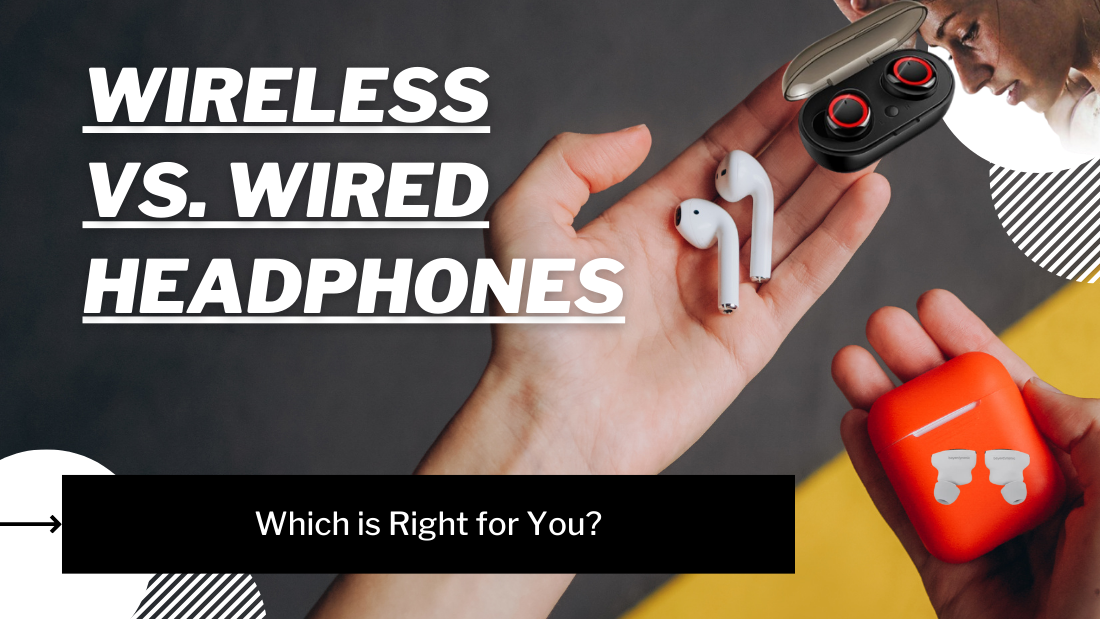In today’s fast-paced world, your audio gear should match your lifestyle. Choosing between wireless and wired headphones can feel like a battle between convenience and performance. In this guide, we break down the pros and cons of both types to help you make an informed decision that suits your daily routine, whether you’re a busy commuter, a dedicated audiophile, or a casual listener.
The Basics of Wired Headphones
Wired headphones have been the standard for decades. They connect directly to your device via a cable, transmitting an analog audio signal that delivers high-fidelity sound. This simple plug-and-play setup guarantees a reliable connection with minimal latency. Because there is no reliance on wireless technology or batteries, you can enjoy uninterrupted listening without worrying about charging.
These headphones shine when it comes to sound quality. Audiophiles love the rich, uncompressed audio that wired connections provide. Many users find that even entry-level wired models deliver more accurate sound compared to their wireless counterparts. Plus, if you ever experience issues, cables are usually easier and cheaper to replace.
Pros of Wired Headphones
- Superior Sound Quality: Wired headphones transmit an analog signal without the need for compression. This results in clearer, more precise audio that audiophiles crave.
- Zero Latency: With no data packet transmission, you experience virtually no delay. This is essential for gamers and professionals who need audio synced perfectly with visuals.
- Reliability: Forget about pairing issues or connectivity dropouts. Wired headphones work as soon as you plug them in.
- Battery-Free Operation: They draw power directly from your device, so you never have to worry about running out of battery mid-listen.
- Cost-Effective: Generally, wired headphones are more affordable, and repairs are simpler and less expensive.
The Drawbacks of Wired Headphones
Despite their strengths, wired headphones come with a few limitations. The most obvious is the cable itself. A cable can restrict movement, making wired headphones less ideal for exercise or travel. Modern devices are also gradually eliminating the 3.5mm headphone jack, meaning you might need adapters to connect your favorite pair.
The Wireless Revolution
Wireless headphones have surged in popularity over the last decade, thanks to advancements in Bluetooth technology and battery life. They offer the ultimate freedom from cords, allowing you to move around without being tethered to your device. This mobility makes them ideal for workouts, commuting, and multitasking at home or in the office.
Wireless models pack a host of extra features. Many come with active noise cancellation (ANC) to block out unwanted sounds. Touch controls, voice assistants, and even multipoint pairing are now standard in many high-end wireless headphones. Although they require charging, improvements in battery technology mean many can last for several hours on a single charge, supporting long listening sessions.
Pros of Wireless Headphones
- Freedom of Movement: Enjoy your music anywhere—at the gym, on a run, or while working from a café—without getting tangled in cables.
- Modern Features: Many wireless headphones include advanced functionalities like ANC, touch controls, and voice assistant integration.
- Ease of Use: Pairing has become almost instantaneous. Once you’ve connected your wireless headphones, they automatically rejoin your device when powered on.
- Sleek Design: Without the bulk of a cable, wireless models tend to have a more modern and stylish look that complements an active lifestyle.
- Compatibility with New Devices: As more smartphones ditch the headphone jack, wireless options provide seamless connectivity with the latest tech.
The Drawbacks of Wireless Headphones
No technology is perfect, and wireless headphones do have their challenges. The reliance on Bluetooth means that sound quality can suffer slightly due to compression, even though newer codecs have minimized this gap. Battery life remains a concern; if you forget to charge them, your listening session could be abruptly interrupted. Additionally, there can be issues with connectivity—such as signal dropouts in crowded areas—though these problems are becoming increasingly rare.
Comparing Wired and Wireless: Making the Right Choice
When deciding between wired and wireless headphones, consider your lifestyle and priorities. If you are a purist who values audio quality above all else or you use your headphones in a stationary setting (like a home studio), wired headphones might be your best bet. They offer unparalleled fidelity, zero latency, and straightforward reliability.
On the other hand, if you lead an active lifestyle or value convenience and mobility, wireless headphones are likely the better option. Their advanced features, comfort, and ease of connectivity make them ideal for dynamic environments. Many users even opt for a hybrid approach—keeping a pair of wired headphones for critical listening sessions and a pair of wireless models for everyday use.
Real-World Applications
For Gamers:
Latency is a critical factor. Wired headphones generally provide a more immediate audio response, which can give competitive gamers a slight edge in fast-paced scenarios. However, high-end wireless models with low latency are closing the gap, making them a viable option if you prefer the freedom of movement.
For Audiophiles:
Sound quality is paramount. Audiophiles might lean towards wired headphones because they deliver a richer and more detailed sound profile. The analog transmission avoids any loss of audio fidelity, which is crucial when listening to high-resolution tracks.
For Fitness Enthusiasts:
The freedom and convenience of wireless headphones are hard to beat. During a run or workout session, having no cables means you can move without interference. Moreover, features like sweat resistance and secure-fit designs are tailored for active users.
For Everyday Use:
If you’re commuting, working, or simply enjoying music at home, wireless headphones offer a balanced combination of sound quality and convenience. Their modern design and smart features can enhance your daily routines without any of the hassle of wires.
Consider Your Budget and Future Needs
Budget plays a significant role in your decision-making process. Wired headphones are often less expensive upfront and have lower maintenance costs. However, as technology continues to advance, wireless headphones are becoming more affordable while offering a wider array of features. Think about what matters most to you and how your usage might evolve over time. If you anticipate using your headphones in varied environments—from the gym to the office—a wireless model might offer greater long-term flexibility.
Enhancing Your Audio Experience
No matter which type you choose, investing in a quality pair of headphones can transform your listening experience. For those ready to upgrade, check out the Premium Headphones Collection to explore a wide range of options. This collection caters to every listener, offering products that blend cutting-edge technology with superior design and performance.
Conclusion
The choice between wireless and wired headphones is highly personal. Wired headphones deliver excellent sound quality, zero latency, and unbeatable reliability, making them ideal for stationary use or professional environments. In contrast, wireless headphones provide the freedom to move, modern features, and convenience that match today’s dynamic lifestyles.
Evaluate your priorities, consider how you use your headphones, and think about your future needs. Whether you’re setting up a home studio, hitting the gym, or simply enjoying music on your daily commute, there’s a perfect pair out there for you. Ultimately, the best choice is the one that enhances your experience and fits seamlessly into your life. Happy listening!






